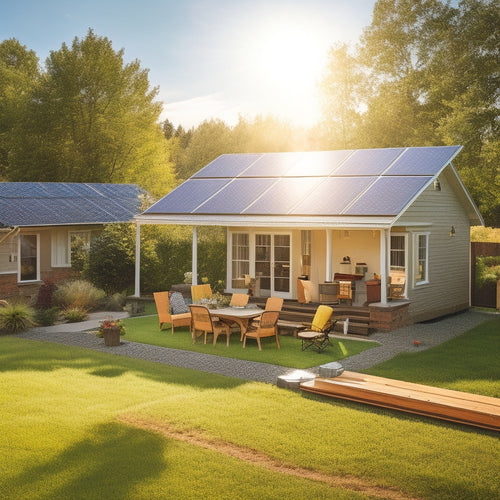
Industrial Solar Energy Installation for Factories
Share
You're investing in a customized industrial solar energy installation for your factory, a strategic decision that can greatly cut operational expenses, reduce your carbon footprint, and enhance your brand's reputation. By conducting a thorough site assessment and energy consumption analysis, you can optimize your solar energy benefits. A well-designed system will meet your energy demands, while adhering to local building codes and regulations. With the right installation and maintenance, you can maximize your ROI through energy savings and incentives. As you investigate the specifics of your installation, you'll uncover the full potential of industrial solar energy for your factory.
Key Takeaways
- A thorough site assessment is crucial to determine the feasibility of a solar energy system and ensure a successful installation.
- Analyzing a factory's energy consumption patterns helps optimize the solar energy system's design and maximize energy savings.
- A well-designed industrial solar energy system can reduce operational expenses, decrease electricity bills, and lower carbon footprint.
- Regular monitoring and maintenance of the solar energy system are essential to ensure optimal performance, longevity, and safety.
- Financial incentives, such as tax credits and grants, can significantly offset the installation costs of an industrial solar energy system.
Benefits of Industrial Solar Energy
As you consider shifting to industrial solar energy, you'll find that one of the most notable advantages is the reduction in operational expenses. By generating your own clean energy, you'll greatly decrease your reliance on the grid and lower your electricity bills. This cost savings can be substantial, especially for factories with high energy demands.
In addition to the financial benefits, industrial solar energy also offers a reduced environmental impact. By utilizing the power of the sun, you'll decrease your carbon footprint and contribute less to greenhouse gas emissions. This not only benefits the environment but also enhances your brand's reputation and compliance with increasingly stringent environmental regulations.
Solar incentives, such as tax credits and grants, can further offset the initial investment costs of installing an industrial solar energy system. These incentives can greatly reduce the payback period, making the shift to solar energy even more appealing.
Factory Roof Requirements Assessment
One significant aspect of industrial solar energy installation is evaluating the factory roof's suitability for solar panel placement. As you consider installing solar panels on your factory roof, you need to assess its ability to support the weight of the panels and withstand environmental factors.
The roof load capacity is a vital consideration, as it determines the maximum weight the roof can handle. You'll need to verify that the roof can support the weight of the solar panels, mounting system, and any additional structural components. Additionally, the solar panel orientation is essential for peak energy generation. The ideal orientation will vary depending on your location, but generally, a south-facing orientation with a tilt between 20-40 degrees is recommended.
| Roof Requirement | Assessment Criteria |
|---|---|
| Roof Load Capacity | Can the roof support the weight of solar panels and mounting system? |
| Solar Panel Orientation | Is the roof orientation suitable for peak energy generation? |
| Structural Integrity | Are there any structural weaknesses or damage that need to be addressed? |
System Design and Planning Phase
During the system design and planning phase, you'll work closely with solar energy experts to tailor a solar panel installation that meets your factory's specific energy requirements and roof constraints. This collaboration guarantees a customized system that maximizes system efficiency and minimizes costs.
A thorough site evaluation is conducted to assess the factory's energy usage patterns, roof orientation, and shading conditions. This information is used to determine the best solar panel layout, inverter selection, and electrical infrastructure requirements.
The design team will also consider local building codes, electrical standards, and grid connection requirements to guarantee compliance.
The resulting system design will provide a detailed plan of the solar panel installation, including the number of panels, panel arrangement, and electrical connections. This plan will serve as a roadmap for the installation team, assuring a smooth and efficient installation process.
Installation and Maintenance Process
With a well-designed solar panel installation plan in hand, you're now ready to proceed with the installation and maintenance process. This vital phase requires careful attention to detail to guarantee a safe, efficient, and long-lasting solar energy system.
During the installation process, it's important to employ advanced installation techniques to maximize energy output and minimize potential risks. This includes confirming proper anchoring and secure fastening of solar panels, using high-quality materials, and adhering to local building codes and regulations.
To guarantee peak performance and extend the lifespan of your solar energy system, regular maintenance is essential. This involves monitoring system performance, cleaning solar panels, and replacing components as needed.
| Installation Techniques | Maintenance Best Practices |
|---|---|
| Secure anchoring and fastening | Regular system performance monitoring |
| High-quality material selection | Scheduled solar panel cleaning |
| Compliance with local building codes | Timely component replacement |
| Professional installation team | Regular software and firmware updates |
Energy Storage and Backup Solutions
You'll need to evaluate energy storage and backup solutions to guarantee a reliable power supply for your industrial solar energy installation.
Battery backup systems provide a stable source of energy during periods of low sunlight or grid outages.
Battery Backup Systems
Most industrial solar energy installations require a reliable energy storage and backup solution to guarantee continuous operation during grid outages or periods of low solar radiation.
As you consider battery backup systems for your factory, you'll want to investigate the latest advancements in battery technology. These advancements have made energy storage more efficient, cost-effective, and reliable.
When selecting a battery backup system, consider the following key factors:
- Depth of discharge: How deeply can the batteries be discharged before recharging is necessary?
- Round-trip efficiency: What percentage of the stored energy can be retrieved and used?
- Cycle life: How many charge and discharge cycles can the batteries handle before their capacity is reduced?
A well-designed battery backup system, integrated with an energy management system, can optimize energy usage, reduce waste, and guarantee a stable power supply.
This allows your factory to operate continuously, even when the grid is down or solar radiation is low. By investing in a reliable battery backup system, you can minimize downtime and maximize productivity.
Power Outage Protection
When the grid fails, your factory's operations come to a halt, resulting in costly downtime and lost productivity. With power outage protection, you can guarantee power reliability and energy independence. This is achieved through energy storage and backup solutions that provide a seamless shift to backup power when the grid fails.
You can integrate energy storage systems, such as batteries, with your industrial solar energy installation. These systems store excess energy generated by your solar panels during the day, allowing you to draw on it during power outages or at night. This guarantees that your critical operations remain online, minimizing downtime and lost revenue.
Backup power solutions, like diesel generators or fuel cells, can also be integrated into your system. These provide an additional layer of power reliability, guaranteeing that your factory remains operational even during extended grid outages.
Grid Connection and Net Metering
You'll need to establish a grid connection to feed excess energy back into the grid and offset your energy consumption.
This process involves working with your utility company to install a net meter, which measures the difference between the energy you produce and the energy you consume.
As you generate electricity, you'll want to understand the metering and billing process to maximize the benefits of your industrial solar energy installation.
Grid Connection Process
Three key components - a grid connection, a net meter, and a bi-directional meter - come together to facilitate the grid connection process.
As you traverse the grid connection process, it's crucial to comprehend the complexities present. You'll need to address grid interconnection challenges, such as verifying your solar energy system meets the utility company's technical requirements.
To guarantee a seamless process, consider the following:
-
Conduct a thorough site assessment to determine the feasibility of connecting your solar energy system to the grid.
-
Comply with regulatory requirements, including obtaining necessary permits and approvals from local authorities and utility companies.
-
Install a bi-directional meter to measure the electricity flowing in both directions between your solar energy system and the grid.
Metering and Billing
After guaranteeing a successful grid connection, your focus shifts to accurately tracking and billing the electricity exchange between your solar energy system and the grid. This is where metering technology plays an essential role.
Advanced metering technology accurately measures the amount of electricity your solar energy system feeds into the grid and the amount of electricity you draw from the grid. This data is vital for billing accuracy, as it determines the net amount of electricity you're exporting or importing.
With net metering, you can offset your energy consumption with the electricity generated by your solar energy system. The metering technology tracks the net energy flow, and you're billed only for the net amount of energy you consume from the grid.
This guarantees that you're accurately compensated for the excess energy you produce. By leveraging advanced metering technology, you can guarantee billing accuracy, optimize your energy consumption, and maximize your return on investment in your industrial solar energy installation.
Industrial Solar Panel Types Used
The industrial solar energy sector employs a range of solar panel types, each designed to meet specific performance, durability, and cost requirements.
You'll encounter different solar panel materials, each with its unique characteristics, advantages, and limitations.
When selecting the right solar panel type for your factory, consider the following factors:
-
Efficiency: Monocrystalline silicon panels offer high efficiency rates, but are more expensive. Polycrystalline silicon panels provide a balance between efficiency and cost. Thin-film panels are the most affordable option, but with lower efficiency rates.
-
Durability: Look for panels with durable materials, such as anodized aluminum frames, and tempered glass or polymer sheets. These can withstand harsh environmental conditions and last longer.
-
Installation techniques: The type of installation technique used can impact the overall performance and cost of the solar panel system. You may opt for fixed-tilt, tracker, or building-integrated photovoltaics (BIPV) installations, depending on your factory's specific needs.
Factory Energy Consumption Analysis
Analyze your factory's energy consumption patterns to optimize your industrial solar energy installation.
Understanding your energy usage is essential to identifying areas of improvement and maximizing the benefits of solar energy.
Start by reviewing your past energy bills to identify consumption trends, such as peak usage hours and seasonal fluctuations.
| Energy Usage Category | Average Daily Consumption (kWh) |
| Lighting | 500 |
| HVAC | 1000 |
| Machinery | 2000 |
Cost Savings and ROI Calculation
With your factory's energy consumption patterns in mind, you're now ready to quantify the financial benefits of your industrial solar energy installation.
The cost savings and ROI calculation is a critical step in justifying your investment in solar energy.
To calculate the ROI, you'll need to take into account the following key factors:
-
Financial incentives: Governments often offer tax credits, grants, or rebates to encourage the adoption of renewable energy sources. These incentives can greatly reduce the upfront cost of your solar energy installation.
-
Energy savings: Calculate the amount of electricity your solar panels will generate and the corresponding reduction in your energy bills.
-
Investment analysis: Evaluate the upfront cost of the installation, the expected lifespan of the solar panels, and the projected maintenance costs to determine the overall ROI.
Frequently Asked Questions
Can Solar Energy Power Factory's Air Conditioning and Cooling Systems?
You can utilize solar energy to power your factory's air conditioning and cooling systems, achieving ideal solar energy efficiency through cooling system integration, allowing for reduced energy costs and a significant carbon footprint reduction.
Are Solar Panels Resistant to Dust and Pollution in Industrial Areas?
"An ounce of prevention is worth a pound of cure." You'll find that solar panels are designed to withstand dust accumulation and pollution impact, with self-cleaning coatings and tilt angles that minimize debris buildup, ensuring peak energy output in industrial areas.
Can Factories Claim Tax Incentives for Solar Energy Installations?
You can claim tax credits for solar energy installations, which greatly reduce installation costs, allowing you to recoup a substantial portion of your investment and increase your factory's bottom line.
Do Solar Panels Require Regular Cleaning for Optimal Performance?
You'll want to prioritize solar panel maintenance, as infrequent cleaning can reduce energy output by up to 25%. Aim for a cleaning frequency of every 6-12 months, depending on your location and environmental factors, to guarantee peak performance and maximize energy yield.
Can Solar Energy Be Used to Power Factory's Water Treatment Systems?
You can utilize solar energy to power water treatment systems by integrating solar panels into the system, reducing reliance on traditional energy sources and increasing overall efficiency, while ensuring consistent water quality through precise solar-powered treatment processes.
Conclusion
By now, you've seen the benefits of industrial solar energy installation for factories, from reduced energy costs to increased sustainability. You've assessed your factory's roof requirements, designed and planned a system, installed and maintained it, and examined energy storage and backup solutions. With grid connection and net metering, you're ready to utilize the power of solar energy. By choosing the right industrial solar panel types and analyzing your factory's energy consumption, you'll reap the rewards of a significant cost savings and a strong ROI.
Related Posts
-

Steps to Prepare for Solar Installation
To prepare for solar installation, start by evaluating your current energy consumption and future needs to determine ...
-

Innovative Sustainable Materials for Energy-Efficient Homes
Innovative sustainable materials enable you to create energy-efficient homes while promoting environmental responsibi...
-

Integrating Smart Technology for Energy Savings
Integrating smart technology into your home is a transformative factor for energy savings. Smart thermostats give you...


